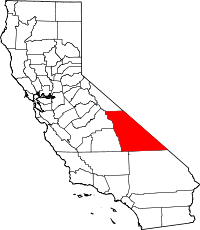Skidoo, California
| Skidoo | |
|---|---|
| Unincorporated community | |
|
Site of Skidoo - Death Valley National Park | |
 Skidoo Location in California | |
| Coordinates: 36°26′08″N 117°08′51″W / 36.43556°N 117.14750°WCoordinates: 36°26′08″N 117°08′51″W / 36.43556°N 117.14750°W | |
| Country | United States |
| State | California |
| County | Inyo County |
| Elevation[1] | 5,689 ft (1,734 m) |
|
Skidoo | |
 | |
|
Skidoo in 1906. | |
| Location | Death Valley National Park, Wildrose District, California |
| Area | 4,160 acres (1,680 ha) |
| Built | 1906 |
| Architectural style | No Style Listed |
| Governing body | National Park Service |
| NRHP Reference # | 74000349 |
| Added to NRHP | April 16, 1974[2] |
Skidoo (formerly, Hoveck)[3] was an unincorporated community in Inyo County, California.[1] The geographical location of the old town site lies at an elevation of 5,689 feet (1734 m).[1] Skidoo is a virtual ghost town located in Death Valley National Park. It is on the National Register of Historic Places.[4]
History
Skidoo was famous in the first decade of the 20th century when gold had been found in the area. Within a decade the town had been abandoned, however, and now no standing structures remain. Skidoo's desert location is visited by ghost town aficionados.
Skidoo is representative of the boom towns that flourished in Death Valley during the early 20th century. The town’s livelihood depended primarily on the output of the Skidoo Mine, a venture operating between 1906 and 1917. During those years the mine produced about 75,000 ounces of gold, worth at the time more than $1.5 million. Two unique items are associated with Skidoo’s mining heyday. First the town possessed the only milling plant in the desert operated almost completely by water power. Second, the construction of the water pipeline was a phenomenal engineering feat; its scar can still be seen between its origin near Telescope Peak and the mill site.
The fifteen-stamp amalgamation and cyanide mill built by the Skidoo Mines Company is a rare surviving example of an early 20th-century gravity-feed system for separating gold from its ore.[5]
Names
The name Skidoo comes from the expression 23 skidoo, a slang expression of the time, for which various origins[6] have been suggested.
The Hoveck post office opened in 1906, changed its name to Skidoo in 1907, and closed in 1917.[3] The name Hoveck honored Matt Hoveck, manager of the Skidoo Mine.[3]
See also
References
- ↑ 1.0 1.1 1.2 U.S. Geological Survey Geographic Names Information System: Skidoo, California
- ↑ "National Register Information System". National Register of Historic Places. National Park Service. 2008-04-15.
- ↑ 3.0 3.1 3.2 Durham, David L. (1998). California's Geographic Names: A Gazetteer of Historic and Modern Names of the State. Clovis, Calif.: Word Dancer Press. p. 1203. ISBN 1-884995-14-4.
- ↑ F. Ross Holland (March 14, 1973). "National Register of Historic Places Inventory — Skidoo" (PDF). National Park Service. Retrieved 2015-04-26. Three photos(1971) and map
- ↑ "Skidoo Quartz Stamp Mill". List of Classified Structures. National Park Service. 2008-11-17.
- ↑ Phrases.org.uk
External links
 Media related to Skidoo (Death Valley) at Wikimedia Commons
Media related to Skidoo (Death Valley) at Wikimedia Commons- National Park Service: Death Valley Ghost Towns
- Historic American Engineering Record (HAER) No. CA-290, "Skidoo Mine, Park Route 38 (Skidoo Road), Death Valley Junction, Inyo County, CA"
| ||||||||||
| ||||||||||||||||||||||||||
| |||||||||||||||||||||||||||||

